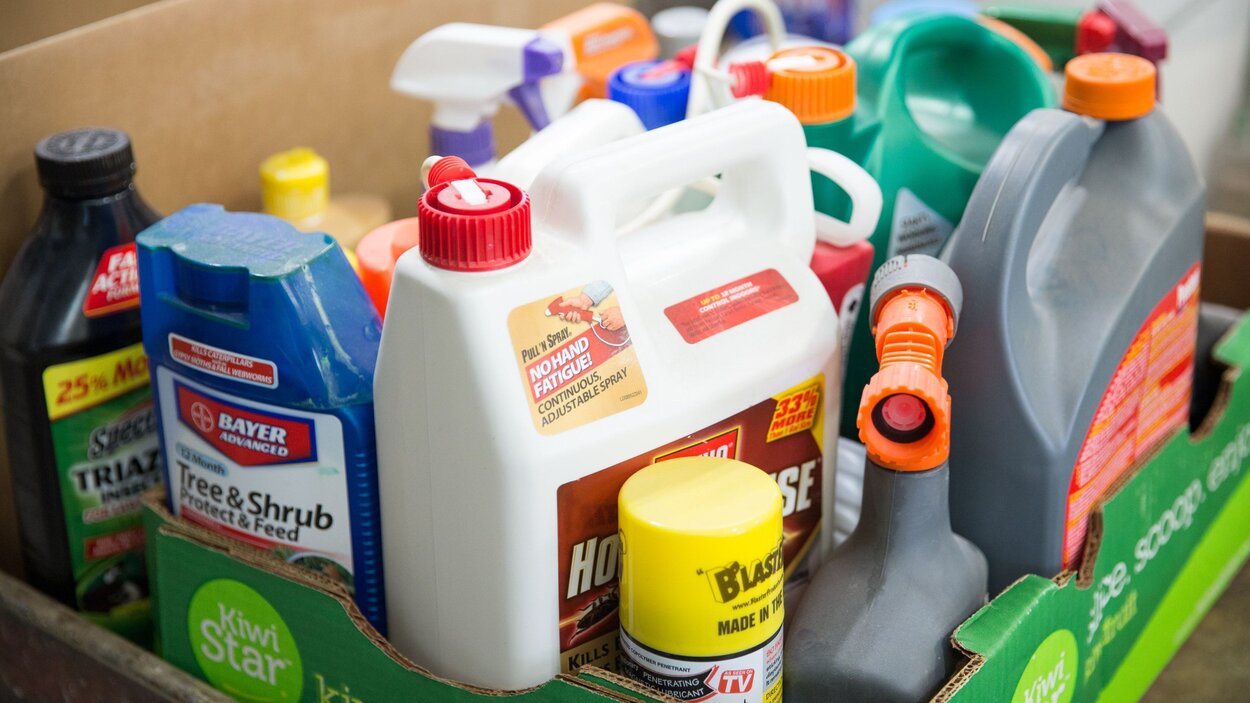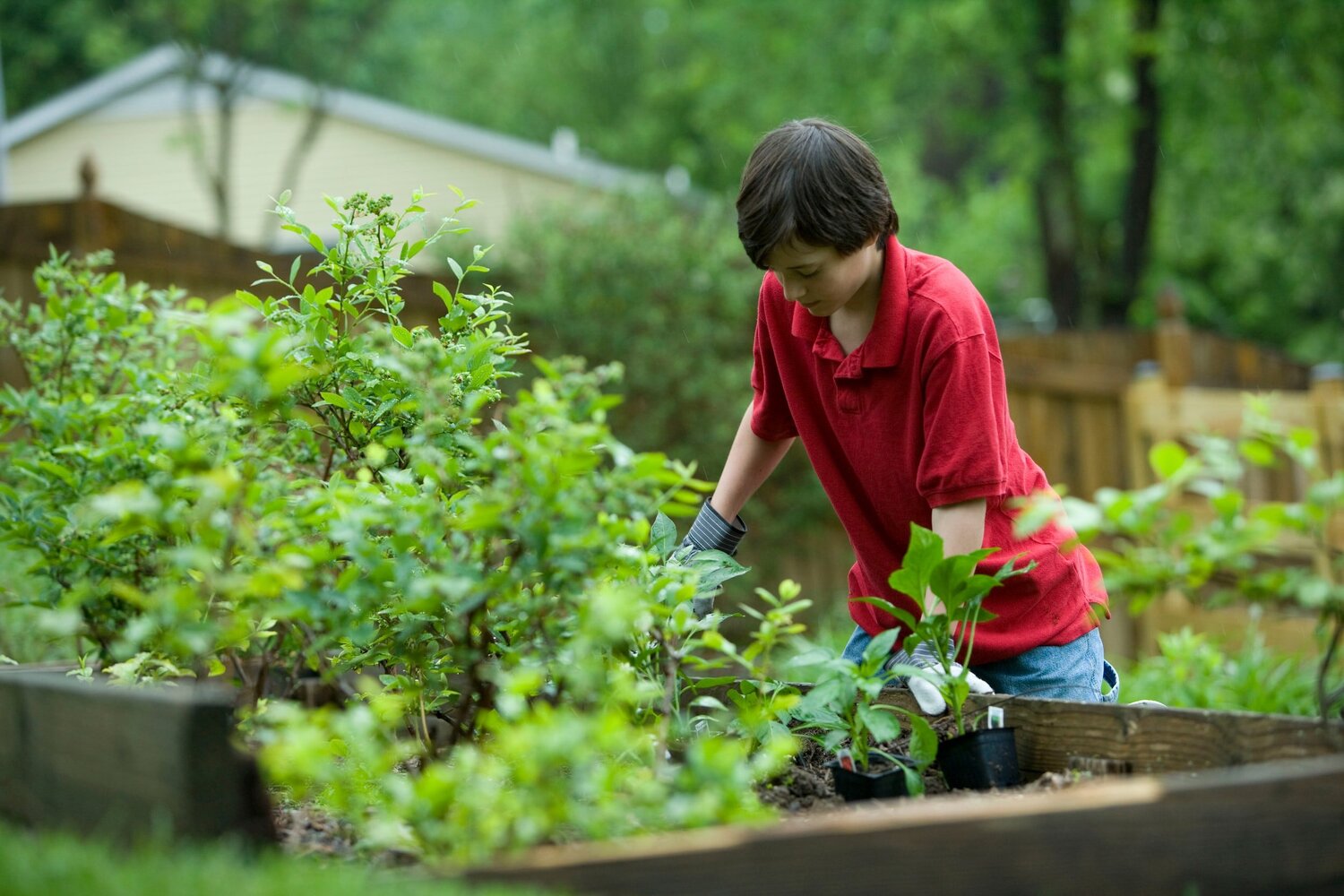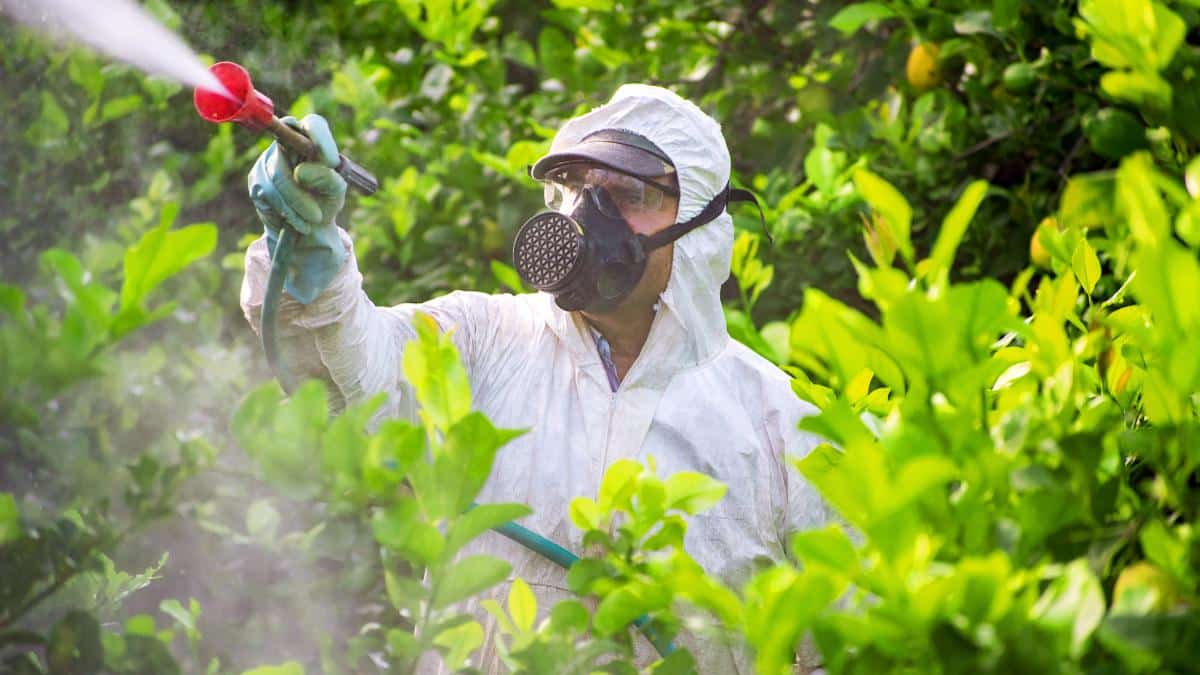Home>Gardening News and Trends>Latest News>How To Dispose Pesticides


Latest News
How To Dispose Pesticides
Modified: January 22, 2024
Stay updated with the latest news on how to safely dispose of pesticides. Learn the proper methods to protect the environment and avoid potential hazards.
(Many of the links in this article redirect to a specific reviewed product. Your purchase of these products through affiliate links helps to generate commission for Chicagolandgardening.com, at no extra cost. Learn more)
Table of Contents
- Introduction
- Types of Pesticides
- Importance of Proper Disposal
- Environmental and Health Risks
- Legal Regulations
- Steps for Disposing Pesticides Safely
- Option 1: Using a Local Collection Program
- Option 2: Repurposing or Donating Unused Pesticides
- Option 3: Creating a Pesticide Waste Mixture
- Option 4: Seeking Professional Assistance
- Precautions to Take During Disposal
- Conclusion
Introduction
Welcome to our comprehensive guide on how to properly dispose of pesticides. Pesticides are chemical substances used to control or eliminate pests that can damage crops, harm human health, or spread diseases. While they play a crucial role in agriculture and public health, it is equally important to handle and dispose of them responsibly to minimize environmental and health risks.
In this article, we will provide you with important information on different types of pesticides, the importance of proper disposal, the potential risks associated with improper disposal, legal regulations surrounding pesticide disposal, and steps you can take to safely dispose of pesticides. Whether you are a farmer, a homeowner, or an enthusiast gardener, understanding and following best practices for pesticide disposal will help protect the environment and ensure the safety of yourself and those around you.
Improper disposal of pesticides can pose significant threats to the environment. When pesticides are not disposed of correctly, they can contaminate soil, water sources, and even the air. This contamination can have severe implications for wildlife, ecosystems, and human health. Therefore, it is imperative to understand the different methods available for safe and responsible disposal of pesticides.
It’s important to note that pesticide disposal methods can vary depending on local regulations and resources. In some areas, there may be specific programs or facilities available for pesticide collection and disposal. In other cases, alternative methods such as repurposing or donating unused pesticides may be appropriate. We will explore these options in detail later in this article.
Now that we have established the significance of proper pesticide disposal, let’s delve into the various types of pesticides commonly used and the potential risks associated with their improper disposal.
Types of Pesticides
Pesticides come in various forms and serve different purposes based on the target pest and the desired outcome. Understanding the different types of pesticides is essential for proper disposal and handling. Here are some common types of pesticides:
- Insecticides: These pesticides are designed to control and eliminate insects, including ants, mosquitoes, termites, and beetles. Insecticides can be further categorized into contact insecticides, systemic insecticides, and stomach poisons.
- Herbicides: Herbicides are used to kill unwanted plants or weeds. They are commonly applied in agricultural settings, gardens, and lawns. Depending on the target weed, herbicides can be selective or non-selective.
- Fungicides: Fungicides are used to combat fungal infections and diseases that affect plants. They are commonly used in agriculture to protect crops from fungal pathogens.
- Rodenticides: Rodenticides are specifically designed to control rodent populations, including rats and mice. These pesticides are often used in homes, farms, and commercial buildings.
- Bactericides: Bactericides are used to control or eliminate bacteria that cause plant diseases. They are commonly applied to crops to prevent bacterial outbreaks.
- Miticides: Miticides, also known as acaricides, are used to control mites and ticks that can harm crops, livestock, and humans. They are commonly used in agriculture, horticulture, and medicine.
- Nematicides: Nematicides are pesticides used to control and eradicate nematode populations. Nematodes are microscopic worms that can damage plants and cause significant yield loss in agriculture.
It’s important to note that these are just a few examples of the types of pesticides available in the market. Each type of pesticide requires specific disposal methods to ensure proper handling and reduce the risk of environmental contamination. Now that we understand the different types of pesticides, let’s explore the importance of proper disposal.
Importance of Proper Disposal
Proper disposal of pesticides is crucial for several reasons. It helps to prevent harmful environmental contamination, protects human and animal health, and ensures regulatory compliance. Let’s explore these reasons in more detail:
1. Environmental Protection: Improper disposal of pesticides can lead to the contamination of soil, water, and air. When pesticides seep into the soil, they can persist for long periods, causing harm to plants, beneficial insects, and other organisms in the ecosystem. Contaminated water sources can affect aquatic life and even contaminate drinking water supplies. Airborne pesticides can drift to neighboring areas, impacting non-target organisms and ecosystems. By disposing of pesticides correctly, we can minimize these environmental risks and protect our natural resources.
2. Human and Animal Health: Pesticides contain chemicals that can be harmful to humans and animals if not handled or disposed of properly. Direct exposure to pesticides can cause a range of health issues, such as skin and eye irritation, respiratory problems, and even more severe conditions like organ damage and cancer. Improper disposal methods, such as pouring pesticides down the drain or throwing them in regular trash, can lead to accidental exposure and potential health hazards. By following proper disposal practices, we reduce the risk of harm to ourselves, our pets, and wildlife.
3. Legal Compliance: Many countries have strict regulations and guidelines in place for the proper handling and disposal of pesticides. Non-compliance with these regulations can result in fines, penalties, or legal consequences. It is important to stay informed about the local laws and regulations regarding pesticide disposal to ensure compliance and avoid any legal issues.
Overall, the proper disposal of pesticides is vital to safeguard the environment, protect human and animal health, and meet legal requirements. In the next section, we will discuss the potential risks associated with improper pesticide disposal.
Environmental and Health Risks
Improper disposal of pesticides can have significant environmental and health risks. Understanding these risks is essential for raising awareness and adopting responsible disposal practices. Let’s explore the potential consequences of improper pesticide disposal:
1. Environmental Contamination: When pesticides are not disposed of properly, they can contaminate soil, water sources, and the atmosphere. Pesticides that seep into the soil can persist for a long time, impacting plant growth and harming beneficial organisms such as earthworms and bees. Contaminated water sources can affect aquatic ecosystems, harming fish and other aquatic life, and potentially entering the food chain. Airborne pesticides can drift to neighboring areas, endangering non-target organisms and sensitive habitats.
2. Bioaccumulation and Biomagnification: Pesticides can bioaccumulate in the body tissues of living organisms over time. As predators consume prey contaminated with pesticides, the toxic chemicals can accumulate in their bodies at higher concentrations. This process, known as biomagnification, results in increased pesticide levels as they move up the food chain. Pesticides that have reached high levels in top predators can have detrimental effects on their health and reproductive capabilities, causing imbalances in ecosystems.
3. Threat to Beneficial Organisms: Pesticides are designed to target pests, but they can also harm beneficial organisms such as bees, butterflies, birds, and natural predators. Bees, crucial for pollination, are particularly susceptible to pesticide exposure. Pesticide residue on plants and in their habitat can lead to declining populations, disrupting the delicate balance of ecosystems and negatively impacting food production.
4. Human Health Hazards: Improper disposal of pesticides can pose significant health risks to humans. Direct exposure to pesticides can cause a range of health problems, including skin and eye irritation, respiratory issues, and even more severe conditions like neurological disorders and cancer. Accidental ingestion, inhalation, or skin contact with pesticides can have immediate and long-term health consequences. Additionally, pesticide residues in food and water sources can also pose health risks if consumed.
These environmental and health risks highlight the importance of proper pesticide disposal practices. By adopting safe disposal methods and following regulatory guidelines, we can mitigate these risks and protect our environment and well-being. In the next section, we will explore the legal regulations surrounding pesticide disposal.
Legal Regulations
Due to the potential environmental and health risks associated with improper pesticide disposal, most countries have established legal regulations and guidelines to ensure the safe handling and disposal of pesticides. These regulations aim to protect the environment, wildlife, and human health. Let’s explore some common legal regulations surrounding pesticide disposal:
1. Registration and Labeling: Before a pesticide can be sold and used, it must undergo a registration process to assess its safety and efficacy. Regulatory bodies conduct thorough evaluations to determine the appropriate usage and disposal instructions for each pesticide. Pesticide labels provide important information, including specific instructions on how to dispose of the product safely.
2. Restricted Use Pesticides: Some pesticides are classified as “restricted use” due to their high toxicity or potential to cause harm to human health or the environment. These pesticides are subject to stricter regulations, and their disposal may require special handling procedures or the assistance of professionals.
3. Disposal Guidelines: Regulatory agencies provide specific guidelines on how to dispose of pesticides safely. These guidelines may vary depending on the type of pesticide and local regulations. Common recommendations include not pouring pesticides down drains or toilets, not throwing them in regular trash, and not burning pesticide containers.
4. Collection Programs and Facilities: Many areas have established collection programs or facilities where individuals and businesses can safely dispose of their unused or unwanted pesticides. These programs often provide guidelines on acceptable disposal methods and may offer scheduled collection events or permanent collection sites.
5. Fines and Penalties: Non-compliance with pesticide disposal regulations can result in fines, penalties, or legal consequences. It is essential to be aware of and adhere to the specific regulations in your region to avoid any legal issues.
It is crucial to note that pesticide disposal regulations may vary between countries, states, and even local municipalities. To ensure compliance, it is recommended to consult your local regulatory agency, pesticide manufacturer, or extension service for specific disposal guidelines applicable to your area.
Understanding and following these legal requirements is essential in order to protect human health, preserve the environment, and comply with the law. In the next section, we will discuss the steps you can take to safely dispose of pesticides.
Steps for Disposing Pesticides Safely
Proper disposal of pesticides is essential to minimize environmental and health risks. If you have unused or expired pesticides that need to be disposed of, follow these steps to ensure safe and responsible disposal:
- Read the Label: Start by carefully reading the pesticide label and instructions for disposal. The label will provide specific guidelines on how to properly dispose of the product, including any precautions or special instructions.
- Check for Local Collection Programs: Research if your area has a local collection program for hazardous waste, including pesticides. These programs are designed to safely collect and dispose of unused or unwanted pesticides. Contact your local environmental or waste management agency for information on collection events or permanent disposal sites in your area.
- Repurpose or Donate: If the pesticide is still usable and within its expiration date, consider repurposing it for its intended purpose or donating it to a local organization, such as community gardens, farms, or pest control professionals. Ensure that the recipient is properly trained and licensed to handle and use pesticides.
- Create a Pesticide Waste Mixture: If you are unable to access a local collection program or find a suitable recipient for the pesticide, you can create a pesticide waste mixture for safe disposal. Mix the pesticide with an inert substance, such as kitty litter, sawdust, or powdered clay, to absorb and neutralize it. Follow the label instructions for the appropriate mixing ratios and transfer the mixture into a sturdy, sealed container.
- Label and Seal the Container: Clearly label the container with the contents, including the name of the pesticide and the date it was mixed. Ensure that the container is tightly sealed to prevent leakage or spills during transportation and storage.
- Contact Local Authorities: Contact your local environmental or waste management agency to inquire about the proper disposal options for the pesticide waste mixture. They will provide guidance on drop-off locations or collection services for hazardous waste.
- Transport and Deliver Safely: When transporting the pesticide waste mixture, ensure it is securely placed in the trunk of your vehicle or another designated area to prevent tipping or leakage. Follow any specific instructions provided by the disposal facility or collection program.
- Store and Dispose of Empty Containers: Empty pesticide containers should be stored safely and disposed of appropriately. Rinse the container thoroughly with water to remove any residue and then puncture or crush it to prevent reuse. Dispose of the empty containers according to local regulations and guidelines.
Remember, it is crucial to handle and dispose of pesticides with care to protect yourself, others, and the environment. Always prioritize safety and follow the instructions and regulations provided by the pesticide manufacturer and local authorities.
Now that we have explored the different methods for safely disposing of pesticides, let’s discuss some precautions to consider during the disposal process.
Option 1: Using a Local Collection Program
One of the safest and most convenient options for disposing of pesticides is to utilize a local collection program for hazardous waste. Many communities have established programs or facilities specifically designed for the collection and safe disposal of chemicals, including pesticides. Here’s how you can take advantage of a local collection program:
- Research Local Collection Programs: Start by researching the hazardous waste collection programs available in your area. Contact your local environmental or waste management agency to inquire about collection events or permanent collection sites.
- Review Accepted Materials: Verify that the local collection program accepts pesticides and their containers. Some programs may have restrictions or specific requirements regarding the types of pesticides they can accept.
- Prepare Pesticides for Disposal: Ensure that the pesticides are properly labeled with their contents and tightly sealed to prevent leakage. If the containers are damaged or leaking, transfer the pesticides to a secure and leak-proof container before taking them to the collection program.
- Schedule a Drop-off: If the local collection program requires an appointment or has specific drop-off hours, make sure to schedule a convenient time for you to safely deliver the pesticides. Follow any instructions provided by the program regarding packaging, transportation, and drop-off procedures.
- Transportation Safety: When transporting the pesticides to the collection program, make sure to securely place them in your vehicle’s trunk or another designated area to prevent tipping or leaking. Avoid transporting them alongside food, drinks, or other items that may become contaminated in the event of a spill.
- Follow Instructions at the Collection Site: When you arrive at the collection program, follow the instructions provided by the staff. They will guide you on where to drop off the pesticides, any required paperwork, and any additional safety measures or precautions to follow.
- Dispose of Empty Containers: If the collection program accepts empty pesticide containers, check with the staff on how to properly dispose of them. They may have specific guidelines or recycling options available.
Using a local collection program ensures that your pesticides are handled and disposed of in an environmentally responsible manner. It also prevents the risk of improper disposal and minimizes potential harm to the environment and human health.
If a local collection program is not available in your area, don’t worry. There are alternative options for safely disposing of pesticides, which we will explore in the upcoming sections.
Option 2: Repurposing or Donating Unused Pesticides
If you have unused or unexpired pesticides that are still in good condition, an excellent option for disposal is to repurpose or donate them. This allows the pesticides to be used effectively instead of being disposed of as waste. Here’s how you can make use of this option:
- Evaluate Pesticide Condition: Check the condition of the pesticides to ensure they are still effective and within their expiration date. Look for any signs of damage, leakage, or deterioration that may affect their usability.
- Identify Potential Recipients: Consider repurposing the pesticides for their intended purpose in your own garden or property. If you have excess pesticides or do not need them, identify potential recipients such as community gardens, farmers, schools, or pest control professionals who may benefit from them.
- Contact Recipients: Reach out to the identified recipients and inquire if they are interested in the pesticides you have available for donation. Ensure that the recipients are properly trained and licensed to handle and use pesticides safely.
- Ensure Proper Handling: Provide instructions and guidelines to the recipients on the proper handling and usage of the pesticides. Ensure that they understand any precautions or safety measures that need to be taken when using the donated pesticides.
- Arrange for Transfer: Once you have identified recipients, arrange for the safe transfer of the pesticides. Ensure that the pesticides are securely sealed and packaged to prevent leakage or spillage during transportation.
- Document the Transfer: Keep a record of the transfer, including the date, recipient’s information, and any relevant details. This documentation can serve as proof of proper transfer and usage.
- Dispose of Unusable Pesticides: If you have pesticides that are no longer usable or have expired, you will need to dispose of them properly. Follow the appropriate disposal guidelines provided by local regulatory agencies or use other disposal options discussed in this article.
Repurposing or donating unused pesticides allows them to be used for their intended purpose and prevents wastage. It also fosters environmental stewardship by reducing the need for new pesticide production and minimizing the generation of hazardous waste.
If using or donating the pesticides is not an option, there are still alternative methods for safe pesticide disposal, which we will explore in the following sections.
Option 3: Creating a Pesticide Waste Mixture
If you are unable to access a local collection program or find suitable recipients for your unused pesticides, creating a pesticide waste mixture is an alternative option for safe disposal. This method involves neutralizing the pesticides to reduce their toxicity before disposal. Follow these steps to create a pesticide waste mixture:
- Gather Necessary Materials: Collect an inert absorbent material such as kitty litter, sawdust, or powdered clay. You will also need a sturdy, sealable container for mixing and storing the waste mixture.
- Read the Label: Start by carefully reading the pesticide label for instructions on how to safely create a waste mixture. The label may provide specific guidelines or recommended ratios for mixing the pesticide with the absorbent material.
- Prepare the Waste Mixture: Follow the label instructions and mix the pesticide with the absorbent material in the designated container. Make sure to wear appropriate personal protective equipment such as gloves and a mask during this process.
- Stir and Seal the Mixture: Thoroughly mix the pesticide and absorbent material to ensure proper absorption and neutralization. Once mixed, seal the container tightly to prevent leakage or spills.
- Label the Container: Clearly label the container with the contents, including the name of the pesticide and the date it was mixed. This labeling is important for identification and to avoid confusion in the future.
- Contact Local Authorities: Contact your local environmental or waste management agency to inquire about the proper disposal options for the pesticide waste mixture. They will provide guidance on drop-off locations or collection services for hazardous waste.
- Transport and Deliver Safely: When transporting the pesticide waste mixture, ensure it is securely placed in the trunk of your vehicle or another designated area to prevent tipping or leakage. Follow any specific instructions provided by the disposal facility or collection program.
- Dispose of Empty Containers: Empty pesticide containers should be properly disposed of according to local regulations and guidelines. Rinse the containers thoroughly with water to remove any residue, puncture or crush them, and dispose of them accordingly.
Creating a pesticide waste mixture is a safe disposal option if other methods are not available. By neutralizing the pesticides, you reduce the risk of environmental contamination and potential harm to human health.
However, it is important to note that this method should only be used as a last resort, as it is preferable to prioritize recycling or reusing pesticides whenever possible. In the next section, we will discuss an additional option for pesticide disposal that involves seeking professional assistance.
Option 4: Seeking Professional Assistance
If you are unsure about how to safely dispose of pesticides or if you have a large quantity of pesticides that need to be handled, seeking professional assistance is a viable option. Professionals such as hazardous waste management companies or local government agencies can provide guidance and expertise in the proper disposal of pesticides. Here’s what you need to know about seeking professional assistance for pesticide disposal:
- Research Local Resources: Start by researching local hazardous waste management companies or government agencies that specialize in pesticide disposal. These professionals have the knowledge and expertise to handle and dispose of hazardous materials safely and in compliance with environmental regulations.
- Contact Professionals: Reach out to the identified professionals and inquire about their pesticide disposal services. Explain your situation, the type and quantity of pesticides you need to dispose of, and any specific concerns you may have.
- Request Information: Ask the professionals for detailed information on their disposal process, any associated costs, and any specific requirements they may have for pesticide packaging or transport.
- Discuss Safety Measures: Inquire about the safety measures they employ to protect their workers, the environment, and the public during the disposal process. This includes proper handling, storage, and transportation of the pesticides.
- Arrange for Pickup or Drop-off: Depending on the services provided, schedule a pickup or arrange for drop-off of the pesticides at the designated location. Follow any specific instructions provided by the professionals regarding packaging, labeling, and transportation.
- Obtain Necessary Documentation: Request documentation or receipts from the professionals to ensure that the pesticides are being disposed of in compliance with regulations. This documentation may be required for record-keeping or to demonstrate proper disposal.
- Ask About Additional Services: Inquire if the professionals offer any additional services, such as decontamination or cleanup of pesticide spills or contaminated areas. This can be especially helpful if you have concerns about the potential contamination of your property.
Seeking professional assistance for pesticide disposal ensures that the process is handled by trained experts with the necessary equipment and knowledge. They can ensure that the pesticides are disposed of safely, preventing harm to the environment, wildlife, and human health.
Remember to verify the qualifications and legitimacy of any company or agency you choose to work with. Ensure that they have the proper licenses and certifications to handle hazardous materials in your area.
Now that we have explored various options for pesticide disposal, let’s discuss some precautions to take during the disposal process to ensure safety and minimize risks.
Precautions to Take During Disposal
When disposing of pesticides, it is crucial to prioritize safety and take necessary precautions to prevent accidents, protect yourself, and minimize the risk of environmental contamination. Here are some key precautions to keep in mind during the disposal process:
- Protective Clothing and Equipment: Wear appropriate personal protective equipment (PPE) such as gloves, goggles, and a mask to prevent direct contact with the pesticides and reduce the inhalation of harmful fumes or particles.
- Well-Ventilated Area: Always work in a well-ventilated area to minimize exposure to any potential fumes or vapors. Open doors and windows or use fans to promote air circulation if working indoors.
- Keep Children and Pets Away: Ensure that children and pets are kept away from the disposal area to prevent accidental exposure to the pesticides. Store the pesticides out of their reach at all times.
- Avoid Mixing Different Pesticides: Do not mix different types of pesticides together, as they may react and produce harmful substances. Dispose of each pesticide separately or follow specific instructions for mixing provided by the pesticide label or disposal guidelines.
- Do Not Pour Down Drains or Toilets: Avoid pouring pesticides down drains, toilets, or other household plumbing. They can contaminate water sources and harm aquatic life. Follow proper disposal methods as outlined by local regulations.
- Handle Containers with Care: Handle pesticide containers with care to prevent spills or breakage. Store them in a secure and stable location to prevent accidental tipping or leaking. Follow instructions on the label for proper storage and handling.
- Do Not Reuse Pesticide Containers: It is important not to reuse pesticide containers for other purposes, as they may still contain residues or residue traces that can be harmful. Follow local guidelines for proper disposal of empty pesticide containers.
- Properly Clean Up Spills: In the event of a spill, take immediate action to contain and clean it up properly. Use absorbent materials such as kitty litter or sand to absorb the spilled pesticide, and dispose of it according to local regulations.
- Follow Local Disposal Guidelines: Familiarize yourself with local regulations and guidelines for pesticide disposal. Consult your local environmental or waste management agency to understand the specific requirements and procedures in your area.
- Keep Emergency Contacts Handy: Keep emergency numbers, such as poison control and local authorities, readily available in case of accidental exposure or emergencies during the disposal process.
By taking these precautions during the pesticide disposal process, you can ensure your safety, protect the environment, and minimize the risks associated with handling and disposing of these potentially hazardous substances.
Now that you are equipped with the knowledge of safe pesticide disposal, you can make informed decisions and contribute to a healthier and safer environment.
Conclusion
Proper disposal of pesticides is crucial to protect the environment, human health, and comply with legal regulations. Understanding the different types of pesticides, the importance of responsible disposal, and the potential risks of improper disposal is essential for anyone working with or handling these chemicals.
By utilizing various disposal options, you can ensure that unused or expired pesticides are handled safely. Local collection programs provide a convenient and environmentally friendly method of disposal. Repurposing or donating unused pesticides allows for their continued use and minimizes wastage. Creating a pesticide waste mixture neutralizes the chemicals before disposal. Seeking professional assistance ensures that large quantities or complex disposal requirements are handled properly.
Throughout the disposal process, it is vital to take precautions and prioritize safety. This includes wearing protective clothing and equipment, working in well-ventilated areas, and keeping children and pets away from the vicinity. Following local regulations and guidelines for storage, transport, and disposal is crucial to ensure compliance and minimize environmental and health risks.
Remember, responsible pesticide disposal is a shared responsibility. By adopting safe disposal practices, we can contribute to a healthier and more sustainable future. Stay informed about the best practices in your area, consult with local authorities or professionals when necessary, and educate others on the importance of proper pesticide disposal.
Together, we can make a positive impact and protect our environment for generations to come.










